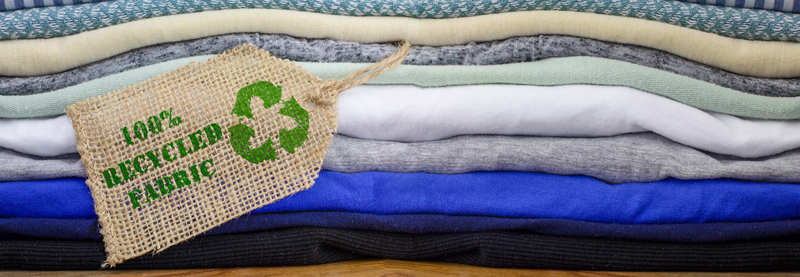
The textile sector in general is dependent on petroleum-based products—including fibers, synthetic chemicals and many accessories—and, importantly, the advanced textiles sector is heavily dependent on synthetic materials. Physical and functionality requirements, such as high strength, and chemical and weather resistance, prevent wide-scale applicability of natural materials.
Therefore, there is need to formulate a sustainability strategy which will address requirements, functionality needs, and cost. This fundamental approach endeavors to balance the need to take care of the earth and affordability.
Sustainability and recyclability
The well-known 3Rs in the green sector is the basic equation upon which sustainability is built. Government agencies, non-governmental agencies (NGOs) and industries have been advocating for reduced use of resources, recycling products, and reusing post-industrial and post-consumer products.
This basic paradigm is working out well, particularly in the case of the textile industry; however, in terms of the advanced and industrial sectors, functionality and quality requirements prohibit a 100 percent sustainability approach. People on both ends of the spectrum on global warming agree on the need to find earth-friendly products and processes. Among the several points of disagreement is cost on both the supply and demand sides, reminding us once again that the economics of sustainability play a key role in the acceptability of a 100 percent sustainability approach in many market segments.
This cost aspect gains more prominence in the changing global trade situation related to unsettled tariff rates. It is certain that tariffs to imported products in the U.S. will add to the cost of products. This trade situation in the author’s view has pushed the sustainability industry one step backwards. Sustainable approaches that can balance the cost and functionality will be the winners. Government agencies and industry must initiate a new level of discussion to make sustainability practically feasible in the new global trade era.
Barriers and moving forward
As is the case with industry generally, economics is the central piece in the decision-making process to move sustainability to the next level. Developed economies like the U.S. and the E.U. do not have economic and strategic advantages to reshore production centers, such as with global brands like Nike and Jockey, from Vietnam or elsewhere. Economists are of the view that even a tariff level of 25 percent will not enable competitiveness to commodity textile manufacturing.
But certainly, trade policies such as closing the de minimis will help SMEs [small and medium enterprises] that focus on innovation and develop products catering to fashion, healthcare and medical sectors. In these sectors, quality may reign over quantity, and hence SMEs may benefit. Such policies may help the advanced textile sector, but it is not clear how T-shirt manufacturers may benefit given the view that the new tariff regimes may not be sufficient to bring shoe and T-shirt manufacturing back to advanced economies.
The manufacturing sector will be best served if they follow the “4S” (sense, shape, shield and sustain) model advocated by the United States’ DARPA [Defense Advanced Research Projects Agency] to plan and develop new products, such as sustainable, value-added materials. Economic factors such as demand, supply, trade policies, and the consumer mindset all play a role in the success of the sustainability sector.
An approach to sustainability
Given the priority to reduce global warming, controlling and curbing environmental contamination is a challenge due to the cost of products and processes, which determine the growth in the use of 100 percent sustainable or biodegradable products. The need for a balanced approach is evident from the draft statement of the first part of the fifth session of the Intergovernmental Negotiating Committee meeting held in Busan, Republic of Korea. One may interpret this as a 4E approach, as if the sustainability marketplace is a four-legged table, which balances:
- Elemental or material sustainability
- Energy and process sustainability
- Environmental sustainability
- Economic sustainability.
While strong advocates of a “green” economy emphasize the numbers 1-3, economic viability, in fact, will be the key driver in growing the sustainable products marketplace. More importantly, in the case of commodity and industrial textiles, two factors are vital determinants: cost and functionality.
A case in point is the 100 percent sustainable oil absorbent. Commercially fine polypropylene fiber meltblown webs are used as sorbents. Recent high-profile research in the space of microplastics has shown the negative effects on human health and the environment. However, the cost associated with a 100 percent biodegradable absorbent is a deterrent. The Nonwoven and Advanced Materials Laboratory at Texas Tech University has proven the science behind the use of low micronaire (discounted) cotton, which is biodegradable in absorbing crude oil. In the commercial place, it did not take off due to its price, compared to polypropylene based sorbents.
A collaboration between Texas Tech University and India-based Jayalakshmi Textiles enabled a compromise of having a synthetic sheath with a biodegradable core. This project approached sustainability by having a balanced approach. Cost reduction in manufacturing was achieved as the production is in India and product sustainability was improved by using blends. Such an approach should be followed wherever possible to be successful.
In the case of defense and healthcare sectors, we have to be realistic, where functionalities such as ballistic protection, toxic chemical decontamination, and fentanyl particle absorption are the drivers. In these sectors penetration of a small percentage of natural materials like cotton will reduce carbon footprint and create new markets for natural fibers.
Organizations like the U.S.-based Cotton Inc. are conducting enormous marketing efforts to bring natural materials into the hygiene and defense sectors. Such efforts are resulting in the use of cotton blends in military applications and natural cleaned cotton for hygiene products. Interestingly, absorbent hygiene products from specialized wool have entered the marketplace. The Northern India Textile Research Assoc. is advocating the use of needle-punched milkweed fibers for advanced applications, and the U.S.’s Hemp Council is promoting value-added products from hemp.
Bottlenecks in the recyclability pathway
Recyclability is one aspect of sustainability, and recycled materials help, but this approach has some barriers, which include:
- In the supply and demand equation, the weak link is the supply aspect, which is related to constraints, such as availability, logistics and cost relative to virgin materials.
- Contamination issues.
- Collection process and distribution.
- Suitable reprocessing and recycling technologies.
- Suitability in certain markets.
These factors are constraints for the availability and the use of recycled materials. Recycled fibers are a desirable choice for manufacturing colored products with “cocktail design” and color effect, but it may not be feasible for those needing a single color, which are needed for institutional fabrics. The cost of recycled material is the primary deciding factor in utilizing them by consumers. Recycled materials have properties that are not on par with virgin materials, which affect processing and marketing, but even so, recycled materials as raw materials are needed in the sustainability equation.
Design and manufacturing approaches
According to Dr. Wyyuru Amarnath, founder and chairman of Chennai, India-based textile technology consultants Sai Invent Consultancy, “Recycling is upcycling and adding value to the waste.” He has come up with many products that consider recycled materials and many of his inventions adopt a reuse policy.
One novel invention is a multifunctional panty which provides pouch to insert an absorbent napkin securely with the help of an invisible zipper. The absorbent napkin, which is biodegradable, can be safely discarded. The disposable component is the absorbent core unlike the whole diaper in many commercial incontinence diapers. This unique design reduces landfill use and provides a balanced approach towards achieving sustainability in a market space dominated by synthetics and single-use products.
One of the issues with using recycled material is the loss of quality compared to virgin materials. Mr. Prasad Rege, former COO of global apparel tech conglomerate MAS Holdings, traced the history of how virgin fiber producers started blending recycled fibers from 5 percent to 50 percent to reach competitive prices. “What started as a ‘blending’ operation for economic value adding has now morphed into an existential requirement. We just cannot go on like this using non-biodegradable synthetic fibers for apparel and other end uses and dump as waste in any part of the world,“ says Rege.
Scientists at India’s Central Leather Research Institute [CLRI] are using an interesting approach in sustainability, i.e., to use naturally occurring biopolymers to produce adhesives, absorbents and hydrogels, so that the final product will be able to biodegrade, as there are less synthetic additives. According to Dr. Swarna Kanth, chief scientist, and Dr. R. Kartik, scientist at CLRI, recent developments include cyto-compatible hydrogels from chitosan, chitosan-based hemostatic agents, and packaging foams using gelatin as a base material.
Sustainability awareness has created more interest in bringing cotton-based carry bags in the place of polyethylene and spunbond nonwoven bags. Dr. Bharani Murugesan, head of the School of Fashion Technology, at KCG College of Technology, Chennai, India, has been upscaling used cotton consumer products, such as like “dhotis” [a traditional trouser-like garment for men] into reusable carry bags. According to Dr. Murugesan, this project has demonstrated the viability of converting traditional garment waste into contemporary, functional products. Sustainable manufacturing has gained prominence in developing packaging products as synthetic-based packaging materials contribute more waste to landfills.
A team of two academics and an industry person are finding solutions to this problem in their own way. South India has lot of banana cultivation and hence there are many byproducts from this plant. The team utilizes banana fibers and their blends with natural fibers to develop biodegradable boxes using starch as adhesive. Professors B. Poongodi of Kumaraguru College of Technology and G. Mohamed Zakriya of KCG College of Technology have teamed up with Seshadri Mukundan of the AUMM Foundation, Chennai, India, in this project.
While prototypes have been developed, lack of funding support from institutional funders is delaying large-scale production of bioboxes. “It’s not easy in today’s world to identify a businessperson who will compromise on the delay for break-even to see profits for sustainability,” says Poongodi.
Understanding and forward progress
The textile industry needs to take a balanced approach to sustainability, engaging natural and earth-friendly processes, as well as synthetic products. In products and applications wherever applicable and acceptable—such as in commodity products—recycled products are advantageous. Even in advanced applications, recycled products can be used that cater to end users’ requirements, but it should be made clear that in case of health care, environment and defense applications, stringent quality standards cannot be compromised.
Going forward, the sustainability pathway should have “3Rs and 4Es” to develop products that have a reduced carbon footprint and required functionality at affordable price levels. Research organizations, academia and industrial associations should work ahead to keep us on the right track, enabling a win-win situation for all involved.
While greater awareness has reached consumers even in the rural areas about the dangers of pollution, global warming and related health effects, the cost of alternative products is a prohibiting factor in bringing out 100 percent sustainable materials. “Unfortunately, over the past few decades this awareness is eroding in some parts of the world, due to a highly consumerist culture,” says Prasad Rege.
But optimism is the way forward where a balanced approach will lead to cost-effective solutions along sustainability pathways. Stakeholders have a great task ahead, which indeed is a good problem to have in this competitive world.
Dr. Seshadri Ramkumar is a professor in the Department of Environmental Toxicology and The Institute of Environmental and Human Health, Texas Tech University, and a regular contributor to Textile Technology Source.
 TEXTILES.ORG
TEXTILES.ORG


